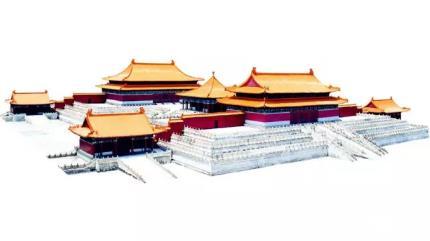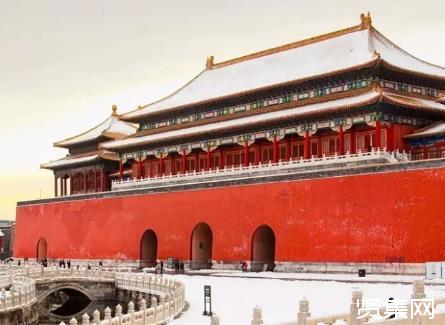Who Designed And Built The Forbidden City? Analysis Of The Architectural Layout And Planning Of The Central Axis Of The Forbidden City
The Forbidden City is the largest palace complex in the world, covering an area of 720000 square meters with hundreds or even thousands of buildings. It is surrounded by defensive fortifications and a 50 meter wide moat. The Forbidden City is an outstanding representative of ancient palace architecture in China, and the buildings located in the central axis area are the essence of it. Here, the "central axis" refers to the connecting line in the north-south direction. So what is the layout of the central axis building in the Forbidden City? Why plan like this? Below is an analysis of the architectural layout and planning of the central axis of the Forbidden City. At the end of the article, who designed and built the Forbidden City is attached. (I believe everyone is also interested in this question. Let's learn more together.)
Based on the observation and induction of astronomical and natural phenomena, ancient Chinese people summarized the relationship between central and central ideas, architecture, and architectural complexes. They closely linked natural laws with construction laws and believed that the north-south orientation was more important than the east-west orientation. The main reason is that during the day, the north-south orientation can be determined based on the projection direction of the sun at noon, while at night, the north-south orientation can be determined based on the position of the North Star. Once the north-south orientation is determined, the east-west orientation is naturally easy to determine.

The planning of many palaces in the Forbidden City reflects the architectural features of facing north and south, with a clear center. As recorded in the "Shuogua Zhuan" of the Book of Changes, "Saints listen to the world from the south and govern towards the bright." Therefore, it can be seen that the architectural complex located in the central position of the north-south direction, which is the central axis position, is the most valued by ancient Chinese people and the core area of palace construction; The central axis architectural complex of the Forbidden City plays an extremely important role in the overall planning of the Forbidden City. The central axis buildings of the Forbidden City from south to north are the Meridian Gate, Taihe Gate, and the Three Great Halls of the Former Dynasty (Taihe Hall, Zhonghe Hall, and Baohe Hall), Qianqing Gate, the Inner Court's Back Three Palaces (Qianqing Palace, Jiaotai Hall, and Kunning Palace), Kunning Gate, Imperial Garden, and Shenwu Gate.
From the perspective of plane layout, the important buildings in the Forbidden City are all located on the central axis, and the plane layout is clever and reasonable. Among them, the Meridian Gate is the southern gate of the Forbidden City and the place where emperors hold important ceremonies. The Meridian Gate is located on a concave city platform, consisting of the city tower and the Yan wing towers on both sides, like a circular fortress, appearing tall and majestic; The Taihe Gate and the Qianqing Gate were the places where the Ming and Qing emperors went to court, respectively. Although their building area was not large, they were in line with the ancient emperor's governing philosophy of "governing by the imperial gate", and there was an open square in front of the gate to facilitate ministers going to court; The Three Great Halls of the Former Dynasty were important places for emperors to hold ceremonies. They were located on a three story high platform, forming a large "earth" shape with the platform on the plane. In ancient Chinese traditional culture, "earth" symbolized imperial power.
After the determination of the central axis building, secondary and ancillary buildings are strictly arranged on both sides of the central axis building in a symmetrical manner, with similar shapes, symmetrical naming, and corresponding functions. This architectural planning approach reflects the characteristics of highlighting the center and central axis.
From the perspective of facade planning, surrounded by ancillary buildings on both sides of the east and west, the buildings along the central axis of the Forbidden City resemble a winding dragon, undulating in height and freely retracting and releasing. Among them, the Meridian Gate is the southern gate of the Forbidden City and the tallest building within the city. The city tower is built on the city platform, like a rising dragon head, displaying deterrent and defensive functions; The three main halls of the Outer Court and the three rear palaces of the Inner Court all have saddle shaped undulating height changes, in an orderly manner from high to low, and then from low to high. The central line of their roofs is like a dragon's body that runs through the north-south undulation of the Forbidden City; And the Qin'an Hall and Shenwu Gate exit in the northern imperial garden have become flattened in the center of their rooftops, like a stretched dragon tail.
The dragon was a symbol of emperors in ancient times, and the architectural planning features of the central axis building complex in the Forbidden City, such as a wandering dragon, reflect the core position and artistic form of the central axis architecture in the Forbidden City. Moreover, the central axis buildings of the Forbidden City also provide rich emotional art on their facades. Ancient craftsmen intertwined these buildings through contradictions such as large and small, wide and narrow, high and low, complex and simple, forming a diverse unity; From subtle guidance, gradually transforming into a majestic subject, then to a grand climax, and finally to a gentle restraint, it gives people visual ups and downs and gradual sublimation of thoughts, producing a perfect emotional effect.
From the perspective of spatial planning, the space south of the Hall of Supreme Harmony and north of the Kunning Palace is enclosed by doors and corridors on both sides. Through the connection and penetration of doors, each seemingly enclosed space is connected into a flowing large space. The six palaces between the Hall of Supreme Harmony and the Palace of Kunning form relatively independent spaces. They are places where emperors govern and empresses engage in activities, with a certain degree of secrecy. They can only be reached from both sides through heavy thresholds and steps.
Although the palace buildings along the central axis of the Forbidden City are arranged separately, they are not completely independent of each other, but complement and coordinate with each other, forming an orderly whole. No matter the central axis buildings of the former dynasty or the inner court, there is a road paved with White Marble in the middle of the square between them. Only the emperor can walk on it, which is called the "Royal Road".
The spatial form of various palace buildings in the central axis architecture is orderly, facing north and south, protruding from the center, symmetrical on both sides, and decorated with imperial roads to create a sense of spatial order and beauty. In addition, different individual buildings emphasize visual emphasis through special dimensions, shapes, and positions, highlighting the hierarchical ideas of feudal etiquette in space.
From the perspective of construction skills, the Forbidden City's central axis architecture is the embodiment of the essence of China's ancient architectural skills. The functional importance and special status of the central axis architecture of the Forbidden City determine the excellence of its construction materials and technology. The Hall of Supreme Harmony, located in the southern part of the central axis, was the venue for important ceremonies held by the Ming and Qing emperors. It is the largest, highest level, and most luxurious palace building in China. The Hall of Supreme Harmony stands on a three story pedestal that reaches a height of 8.13 meters, highlighting its unparalleled grandeur and majesty, representing the ultra-high level of ancient Chinese architectural skills.
From a cultural perspective, the ancient architecture along the central axis reflects the order, etiquette, and moral concepts of ancient Confucian thought in China. Taking architectural naming as an example for explanation. The names of the Hall of Supreme Harmony and the Hall of Supreme Harmony are derived from the Confucian classic "The Book of Changes", which states that "the Great Harmony of Supreme Harmony is the virtue of righteousness.". Among them, "Da" means "Tai", "Taihe" implies the harmony and unity of all things in the universe, and "Baohe" means the unity of mind to maintain harmony among all things; The word "Zhonghe" in the Zhonghe Hall is taken from the Book of Rites - The Doctrine of the Mean, which states that "Zhongyi" is the foundation of the world; "Heyi" is the way of the world, encouraging the emperor to act impartially and adhere to the Doctrine of the Mean. From this, it can be seen that the central axis architecture of the Forbidden City itself contains rich cultural connotations.
Who built the Forbidden City?
In Chinese history, there were many famous palaces. For example, the Qin Afang Palace was shut down before it was repaired, the Han Weiyang Palace was reduced to ruins, and the palaces of Tang Chang'an, Song Bianliang, and Yuan Dadu can only be traced back to the literature and ruins today. Only the Forbidden City palaces of the Ming and Qing dynasties have been preserved intact to this day, towering and magnificent, with endless scenery! The scale and construction of the Forbidden City are rare miracles in the history of architecture!
As the imperial palace of the Ming and Qing dynasties, the Forbidden City has been extremely majestic and mysterious for hundreds of years. It was not until it was converted into a museum that its true appearance gradually became public to the world. The Forbidden City is located on the central axis of Beijing, where 24 emperors of the Ming and Qing dynasties lived. For hundreds of years, great military and state policies were issued, changing the fate of generations of Chinese people.
The literature and physical objects related to the Forbidden City are exceptionally rich, but unfortunately, there is a lack of information on architectural designers. In that era, the social status of craftsmen was not high. Although there was a construction army of several million people when it was first built, only a few left their names. As for who the designer was, it became a historical mystery. Who is responsible for designing the Forbidden City?
The Forbidden City of the Ming Dynasty
Such a great building, but upon careful consideration, it is extremely terrifying!
600 years ago, as a typical wooden building, these woods have not decayed or rotted for hundreds of years.
How were those giant stones weighing over 200 tons transported to the capital?
Who exactly do these incredible powers come from?
Although there is an exceptionally rich collection of literature and physical objects related to the Forbidden City, unfortunately, there is a lack of information on architectural designers. In that era, the social status of craftsmen was not high, and only a few left their names. As for who the designers were, it became a historical mystery.
The materials were prepared for 11 years
In 1402, Yan King Zhu Di, who had been guarding the north, finally seized the world of his nephew Emperor Jianwen and became the third emperor of the Ming Dynasty.
Shortly after Zhu Di ascended the throne, the imperial censor Jing Qing, who was determined to seek revenge for Emperor Jianwen, attempted to assassinate him in the court and almost took Zhu Di's life. Afterwards, he often had nightmares and was not used to the humid and hot weather in Nanjing, so he strongly missed the base city of Beijing where he had lived for many years. So, a massive project began.

Zhu Di first dispatched personnel to various parts of the country to mine precious wood and stone materials, and then transported them to Beijing. Just the preparation work lasted for 11 years.
Precious nanmu grows mostly in the steep mountains, and people venture into the mountains to pick wood, causing many people to lose their lives. In later generations, the phrase "entering the mountain for a thousand, leaving the mountain for five hundred" was used to describe the cost of life paid by logging.
Extracting stones for building palaces is equally difficult. How did the largest Danshi stone behind the Baohe Palace, weighing over 200 tons, be transported to the Forbidden City after being mined in Fangshan, southwest of Beijing?
History records the scene of transporting it:
Tens of thousands of laborers dig wells every mile or so on both sides of the road, and when the temperature is low enough in the cold winter of the twelfth lunar month, they pour water from the wells into ice lanes. It took 28 days to deliver it to the palace. In addition, it is necessary to fire square bricks specifically for royal architecture in Suzhou - golden bricks. Most of the materials from these regions were shipped through the Grand Canal, which gave rise to the saying "First there was the Grand Canal, then there was the city of Beijing.".
Who designed the Forbidden City?
In the fifteenth year of the Yongle reign, Zhu Di began to mobilize a large number of skilled craftsmen from the south to carry out large-scale construction and build palace cities. The Forbidden City was designed and planned strictly in accordance with the feudal patriarchal system, with the front three main halls serving as the outer court, where the emperor handled government affairs; The palace complex behind is the inner court, which is the living quarters of the emperor's family. The Left Ancestor (Temple) and Right Society (Altar of State), as well as the traditional theory of Yin Yang and Five Elements, have also been applied in the architecture of the Forbidden City. So who was responsible for designing this magnificent architectural complex?
The first statement: Kuai Xiang
According to the most widely circulated theory, the designer of the Forbidden City was an outstanding craftsman from the Ming Dynasty, surnamed Kuai ("ku") ǎ I) Mingxiang. He was born in the 31st year of Hongwu and passed away in the 17th year of Chenghua. He was from Xiangshan, Wu County, Suzhou. At that time, among the craftsmen who entered the capital, there was a Xiangshan gang, all of whom were Xiangshan people from Wu County or their disciples. They are often skilled in carpentry, including outstanding masons, lacquersmen, stonemasons, ash stackers, sculptors, and painters, and Kuai Xiang is the leader of the craftsmen of the Xiangshan Gang.
Kuai Xiang
The emperor called him "Kuai Luban".
Kuai Xiang is very clever. When building palaces and towers, he only needs to make a slight calculation to draw the design drawings. After the construction is completed, the size and dimensions of the building are exactly the same as the drawings. Kuai Xiang's architectural skills were highly praised, and the emperor often referred to him as Kuai Luban. The Forbidden City was built in 1420, but only 9 months later it caught fire due to lightning strikes. It was not until the Zhengtong period that the imperial court repaired it again, and Kuai Xiang was still responsible for this. The character depicted under the Chengtian Gate (equivalent to today's Tiananmen Gate) in a Ming Dynasty palace city painting currently in the collection of the Chinese History Museum is said to be Kuai Xiang.
Kuai Xiang later became the Left Assistant Minister of the Ministry of Works. In his later years, although he resigned and retired, whenever someone asked him for advice on construction projects, he was very enthusiastic in providing guidance. In the past, there was a Kuai Shilang Hutong in Beijing, and it is said that he once lived there. Most of Kuai Xiang's descendants inherited his skills, and even in the late Qing Dynasty, there was still a saying that "all skilled craftsmen in Jiangnan carpentry come from Xiangshan.".
The second statement: Cai Xin
History is vast like a sea of smoke, burying many secrets. There are also many doubts about Kuai Xiang being the designer of the Forbidden City. Mr. Yu Zhuoyun, who used to be a senior engineer in the Department of Ancient Architecture at the Palace Museum, believes that when Kuai Xiang entered the capital at a young age, the construction of the palace was already a crucial moment, and it was impossible to start designing at this time. The true designer is the unknown Cai Xin.
Li Xieping, a researcher at the Department of Ancient Architecture of the Palace Museum, also questioned that when the Palace Museum was first built in 1417, Kuai Xiang was less than 20 years old, making it difficult for him to design the entire project in terms of age and qualifications. Kuai Xiang's contribution should mainly be reflected in the reconstruction work of the orthodox era. The Cai Xin mentioned by Yu Zhuoyun was from Wujin in Southern Zhili. His birth date and year cannot be verified, but there is a story circulating among the people about his involvement in the design of the Forbidden City.
It is said that at that time, Zhu Di entrusted the task of building a palace to the Minister of Works, Song Li. To build a palace, there must be a blueprint first, and Song Li found Cai Xin to design it. Cai Xin quickly handed in his answer sheet. Song Li looked at the design and was very satisfied! The New Imperial City moved slightly southward compared to the Yuan Dynasty; The major palaces, along the central axis, are very orderly with their left ancestors and right societies; Digging into the South China Sea and piling up Jingshan. The entire design is square and steady, symbolizing the long-term stability of the Ming Dynasty.
The third statement: Yang Qing
Another expert suggests that the designer of the Forbidden City should be Yang Qing. But he left less information, only knowing that he was a bricklayer. It is said that even the name Yang Qing was given by Zhu Di.
Other claims: Court officials oversee decision-making
Some people, based on the above statements, believe that Cai Xin and Yang Qing played a significant role in the early construction of the Forbidden City. But at that time, the two were already old, so after Kuai Xiang entered the capital, due to his young and strong age, he participated in the design and construction of Nanjing palaces, and was good at calculation and painting. Therefore, the main design and construction work was completed by him, and his position and role were thus highlighted.
Researcher Li Xieping believes that the construction of the palace is ultimately supervised and decided by court officials. Whether it is Kuai Xiang, Cai Xin, or Yang Qing, they are only responsible for specific trades such as wood, stone, and painting.
The Forbidden City is a masterpiece of ancient Chinese palace art and one of the most magnificent palace architectural complexes in the world. A large number of craftsmen and civilians have put in great effort and even sacrificed countless lives for this, but unfortunately they have all been forgotten. For us today, the Forbidden City is more like a collective performance by architects hundreds of years ago, reflecting the collective wisdom of the Chinese nation.
So everyone, do you believe in miracles?
The skilled craftsmen who are purely handcrafted have created miracles of art with their hands.
A large number of craftsmen and civilians have put in great effort and even sacrificed countless lives for this, but unfortunately they have all been forgotten. Perhaps you can hear the poet Xichuan's words: history only records the great achievements of a few people/the words of others merge into silence.
We have always believed in miracles, but we do not believe that we are the creators of that miracle.
When we encounter something that feels impossible, we often magnify the difficulties in our imagination. So some things, before we take action, we have already given up and given up. People who only hope for miracles will not do so. Only those who create miracles with their own hands can truly be blessed by heaven.
Just like the builders of the Forbidden City 600 years ago.
(Author Zhou Qianxi, Research Librarian of the Palace Museum and official account of Life and Art)
Source: Life and Art/Science and Technology Daily
Note: All accompanying images in the article are reposted online. Any infringement will result in deletion!
Original link: https://www.xianjichina.com/news/details_186847.html
Source: Xianji.com
The copyright belongs to the author. For commercial reprints, please contact the author for authorization. For non commercial reprints, please indicate the source.


